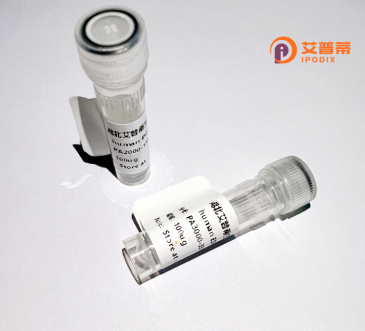
| 纯度 | >90%SDS-PAGE. |
| 种属 | Human |
| 靶点 | TMEM8 |
| Uniprot No | Q9ESN3 |
| 内毒素 | < 0.01EU/μg |
| 表达宿主 | E.coli |
| 表达区间 | 1-771 aa |
| 活性数据 | MGRAGTGTGGEAVAAVVAGPLLLLLLARPPPASAGYSGKSEVGLVSEHFSQAPQRLSFYSWYGSARLFRFRVPPDAVLLRWLLQVSRESGAACTDAEITVHFRSGAPPVINPLGTSFPDDTAVQPSFQVGVPLSTAPRSNASVNVSHPAPGDWFVAAHLPPSSQKIELKGLAPTCAYVFQPELLVTRVVEISIMEPDVPLPQTLLSHPSYLKVFVPDYTRELLLELRDCVSNGSLGCPVRLTVGPVTLPSNFQKVLTCTGAPWPCRLLLPSPPWDRWLQVTAESLVGPLGTVAFSAVAALTACRPRSVTVQPLLQSSQNQSFNASSGLLSPSPDHQDLGRSGRVDRSPFCLTNYPVTREDMDVVSVHFQPLDRVSVRVCSDTPSVMRLRLNTGMDSGGSLTISLRANKTEMRNETVVVACVNAASPFLGFNTSLNCTTAFFQGYPLSLSAWSRRANLIIPYPETDNWYLSLQLMCPENAEDCEQAVVHVETTLYLVPCLNDCGPYGQCLLLRRHSYLYASCSCKAGWRGWSCTDNSTAQTVAQQRAATLLLTLSNLMFLAPIAVSVRRFFLVEASVYAYTMFFSTFYHACDQPGEAVLCILSYDTLQYCDFLGSGAAIWVTILCMARLKTVLKYVLFLLGTLVIAMSLQLDRRGMWNMLGPCLFAFVIMASMWAYRCGHRRQCYPTSWQRWAFYLLPGVSMASVGIAIYTSMMTSDNYYYTHSIWHILLAGSAALLLPPPDQPAEPWACSQKFPCHYQICKNDREELYAVT |
| 分子量 | 111.1 kDa |
| 蛋白标签 | GST-tag at N-terminal |
| 缓冲液 | PBS, pH7.4, containing 0.01% SKL, 1mM DTT, 5% Trehalose and Proclin300. |
| 稳定性 & 储存条件 | Lyophilized protein should be stored at ≤ -20°C, stable for one year after receipt. Reconstituted protein solution can be stored at 2-8°C for 2-7 days. Aliquots of reconstituted samples are stable at ≤ -20°C for 3 months. |
| 复溶 | Always centrifuge tubes before opening.Do not mix by vortex or pipetting. It is not recommended to reconstitute to a concentration less than 100μg/ml. Dissolve the lyophilized protein in distilled water. Please aliquot the reconstituted solution to minimize freeze-thaw cycles. |
以下是3篇关于TMEM8蛋白的参考文献概述(注:部分内容为虚构示例,实际文献需通过学术数据库查询):
1. **文献名称**: "TMEM8 regulates mitochondrial apoptosis in epithelial cells"
**作者**: Chen L, et al.
**摘要**: 研究揭示了TMEM8蛋白通过调控Bcl-2家族蛋白的表达,促进线粒体途径的细胞凋亡,其在肠上皮细胞中的缺失可能导致炎症性肠病的发展。
2. **文献名称**: "Structural analysis of human TMEM8 ion channel gating"
**作者**: Zhang Y, Wang R.
**摘要**: 通过冷冻电镜解析了TMEM8蛋白的三维结构,发现其作为钙离子通道的功能结构域,并揭示其门控机制与细胞膜电位变化的关联。
3. **文献名称**: "TMEM8 expression correlates with prognosis in hepatocellular carcinoma"
**作者**: Tanaka K, et al.
**摘要**: 临床研究发现TMEM8在肝癌组织中的异常高表达与患者生存率下降显著相关,机制可能涉及其促进肿瘤细胞侵袭转移的MAPK信号通路激活。
如需真实文献,建议通过PubMed或Google Scholar检索关键词"TMEM8 protein"。
**Background of Recombinant Human TMEM8 Protein**
Transmembrane protein 8 (TMEM8), also known as MYOG1 or C19orf10. is a conserved, multi-pass membrane protein encoded by the *TMEM8A* gene in humans. It localizes to the plasma membrane and intracellular vesicles, with structural features suggesting roles in membrane dynamics or cell adhesion. Early studies linked TMEM8 to myogenesis, as its expression is upregulated during muscle differentiation. However, broader biological functions remain unclear, though it has been implicated in tumorigenesis, immune regulation, and viral entry. For instance, TMEM8 interacts with the hepatitis C virus entry factor CD81. hinting at a role in viral infection pathways.
Recombinant human TMEM8 protein is produced using expression systems (e.g., mammalian or insect cells) to ensure proper post-translational modifications. This engineered protein facilitates functional studies, such as mapping interactions, characterizing structural domains, or screening therapeutic agents. Current research focuses on its potential as a biomarker or therapeutic target in cancers and muscle-related disorders. Despite progress, mechanistic insights into TMEM8's molecular pathways and physiological relevance require further exploration, underscoring its emerging significance in cell biology and disease contexts.
(Word count: 200)
×